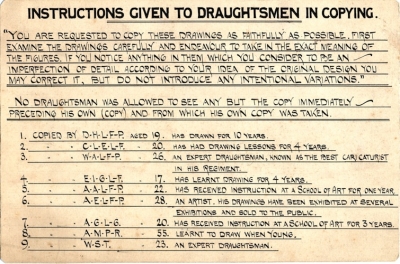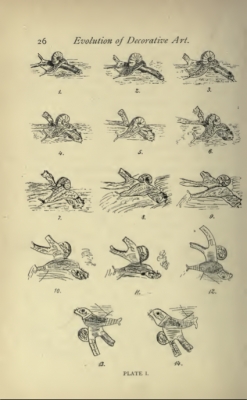Pitt Rivers' investigations into the degeneration of artistic images
In 1884 Pitt-Rivers gave an address to the art students at Dorchester School of Art. This is probably the closest he ever came to making clear his artistic interests. For Pitt-Rivers making sense of things often meant identifying similar types of things, or plotting progression (as in the supposed evolution of artefactual form), or creating series of apparently related objects that appeared to change from the simple to the complex. One of his beliefs, first expressed in 1875 in 'The Evolution of Culture', was that abstracted designs were often 'degenerations' of 'accurate' depictions of other forms. He illustrated it with this famous set of examples of paddle decoration (see picture here). He explored this theme at greater length in 1884. In the course of his 1884 address he said:
I tried the experiment of taking a number of realistic drawings of different subjects, and submitted them to the process of having them copied successively by nine people, all of whom had undergone a course of instruction in drawing with various degrees of proficiency. Each person was instructed to copy from the last copy only and not allowed to see the copies which preceded it, so that the changes took place unconsciously on the part of the draughtsmen. The results which are exhibited on a series of cards show that changes fully as great, and very much in the same character took place, notwithstanding that all were educated persons of our own race who had been trained to draw, some being quite proficient artists. It would take too long to describe these drawings; they can be examined afterwards by any of those present who are interested in the subject. Each drawing is marked in the order in which the copy took place. These examples serve to illustrate the process by which changes took place in the forms and ornaments of antiquity.
Pitt-Rivers seems to have taken this game or experiment very seriously. In the Salisbury and South Wiltshire Museum holdings are a series of instructions on methodology:
Instructions given to Draughtsmen in Copying
"You are requested to copy these drawings as faithfully as possible first examine the drawings carefully and endeavour to take in the exact meaning of the figures. If you notice anything in them which you consider to be an imperfection of detail according to your idea of the original design you may correct it but do not introduce any intentional variations."
"No draughtsman was allowed to see any but the copy immediately preceding his own (copy) and from which his own copy was taken ..." [Salisbury and South Wiltshire Museum Pitt Rivers papers: M39]
It is clear that the draughtsmen were members of his own family, and their drawing experience is outlined in the talk. He returned to this theme some five years later during a talk at the Blackmore Museum, Salisbury. This section of his talk dealing with this 'game' which he describes as variation on the whispering game of 'Chinese whispers', or what he terms 'Russian Scandals', can be seen here.
This experiment was to intrigue several of his successors.
Balfour also used the copying game as a research tool when he was working on the 'evolution of art'. He argued that copying was one of the main causes for variations in designs – he described man as an imitative creature (1894: 458). Successive copying led to ‘unconscious variation’ and ‘conscious variation’ in design. He explored the creative potential of successive copyings with a practical experiment, which was a bit like Chinese Whispers on paper. It had been suggested to him by General Pitt Rivers some years before (Pitt Rivers Museum manuscript collections: Henry Balfour box 4A, Handwritten ‘Essay upon the Evolution of Decorative Art, as especially illustrated by the Art of Modern Savages’) ‘A sketch representing a snail crawling over a twig, which I gave out to, for the most part, fairly unskilled hands to copy, successively went through a series of rapid changes, and became, in the course of some fourteen copyings, a kind of bird-like figure’ (ibid: 459). In a similar ‘unconscious variation’ experiment, he found that the head of a Greek warrior morphed into a woman wearing a cloak. [See here for a full version of Balfour's description of this game]
The experiment was designed to illustrate the affect of gradual, slight modifications in form over time: ‘although no two adjacent sketches exhibit very marked differences; the extremes of the series show hardly any resemblance to each other, and, if seen apart from their series, would certainly not be recognised as the same design.’ (Pitt Rivers Museum manuscript collections: Henry Balfour box 4A). Balfour acknowledged that the participants’ lack of skill had played its part in the experiment’s success, but argued that his intention had never been to end up with a copy that was completely different from the original. Furthermore, the unskilled artists were presumably chosen to represent the supposedly limited abilities of 'primitive' man. The original slips of paper which Balfour used for this experiment survive in the Pitt Rivers Museum manuscript collections (Henry Balfour box 4A), and some of the names of the participants are recognisable: J.T. Long, W. Beale, H. Long, H.S. Arnold, W. Cawdel, P. Walters, G. Haynes, E. Westal, J. Penn, A. Walker, W. Rolph, Egington, [E.F. Reed], A. Robinson [an experienced artist]. Robinson and Long both worked in the Pitt Rivers Museum as assistants.
Balfour also spread the word among his colleagues. A letter survives in the archives of the Oxford University Museum of Natural History from a donor to the Pitt Rivers Museum, Eustace Neville Rolfe, to Henry Balfour, written 29 May 1893:
Your ‘successive copying’ series has reached me + I am delighted with it, it is a very good instance of gradual though ultimately radical change. Many thanks for it. It really makes a splendid kind of game, being a pictorial form of the game known as ‘Russian Scandal’. I want when I have time to start a series which shall branch off in different directions thuswise, [sketch of branching arrows] I think one would get some curious results. At certain stages two people would copy the same drawing + so start the ball rolling in two different directions as a very small difference would set up two quite diverging lines of growth or ‘devolution’. I have just got a good case of successive copying in engravers work. Beginning with a 16th century watercolour + passing through 17th + 18th cen. Engravings to one in one of Sir John Lubbock’s books. One detail is curious: several dancing native Virginians in the original hold rattles made of gourds in their hands and the changes in successive engraving of one of these gourds is interesting. [sketch of three ‘gourds’ labelled A B and C]. In the original the gourd is shaded both sides to make it look round (A), in a later engraving the shading is on one side only + very dark, the outline on the other side being faint (B). In Lubbocks engraving the shading alone has been reproduced making an aimless sort of baton of dissolute appearance in no way resembling the gourd projenitor. If I ever reach a second edition I shall incorporate this as it brings the importance of ‘unconscious variation’ home to one.
AP with Frances Larson and Chris Wingfield, June 2010
Bibliography for this article
Balfour, Henry. 1893. 'The Evolution of Decorative Art: An essay upon its origin and development as illustrated by the art of modern races of mankind' London Rivington, Percival and Co.
Balfour, Henry. 1894. ‘Evolution in Decorative Art’ Journal of the Society of Arts, no.2 vol XLII p. 162
Bowden, Mark. 1991. Pitt Rivers: The Life and Archaeological Work of Lieutenant-General Augustus Henry Lane Fox Pitt Rivers, Cambridge: Cambridge University Press.
Fox, A.H. Lane. ‘On the Evolution of Culture’ Journal of the Royal Institute, 7 [1875] pp. 357-389
Pitt-Rivers, A.H.L.F. 1884. 'Address delivered at the Annual Meeting of the Dorchester School of Art, February 1884' Dorset Chronicle, February 7 1884 (pagination unknown)
Pitt-Rivers, A.H.L.F. 1906. [ed. JL Myers, intro by Henry Balfour] The Evolution of Culture and other essays Clarendon Press Oxford UK
Thompson, Michael and Colin Renfrew. 1999. ‘The catalogues of the Pitt-Rivers Museum, Farnham, Dorset’ Antiquity vol. 73 (no. 280) pp. 377-392




